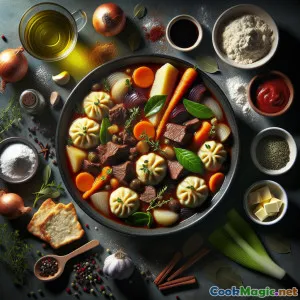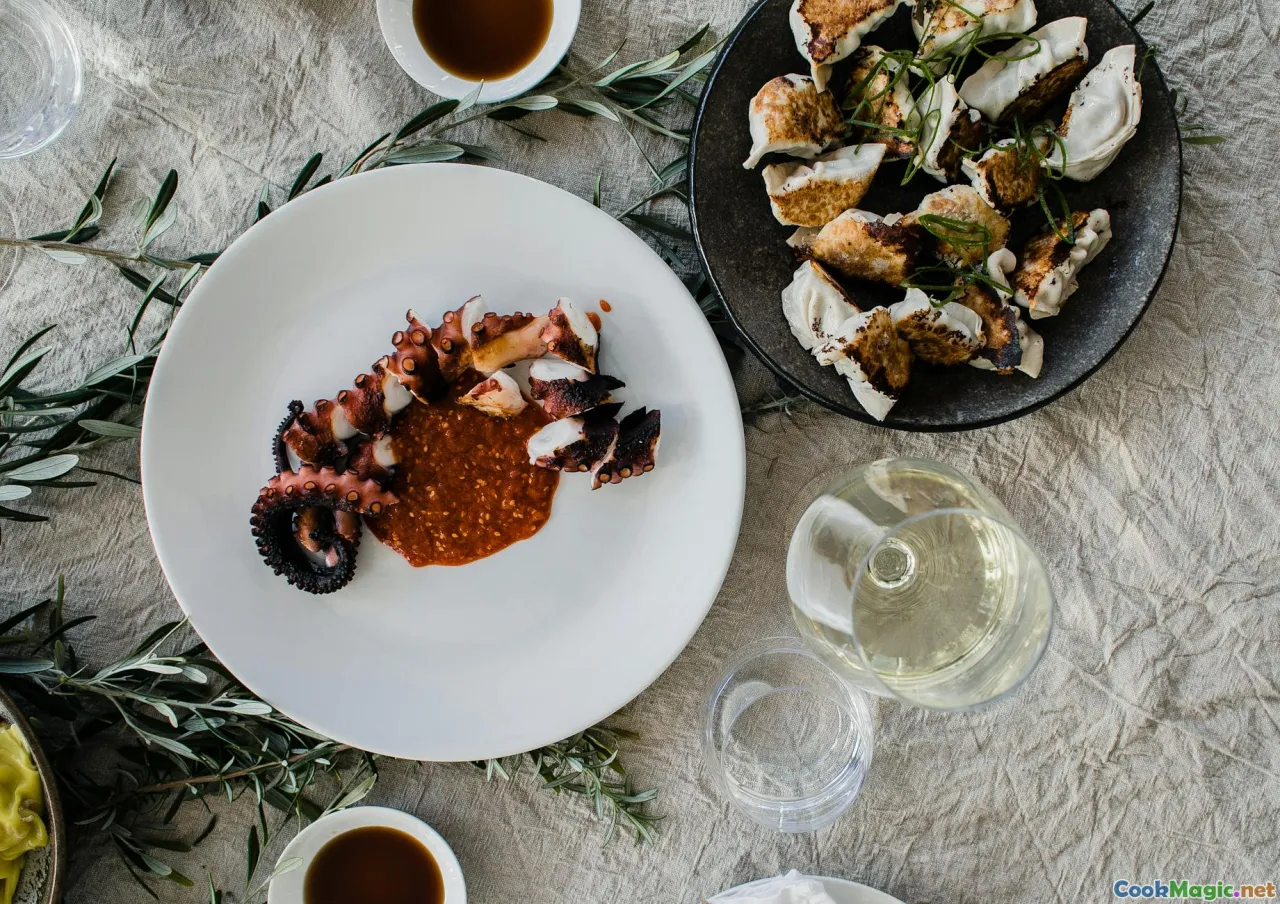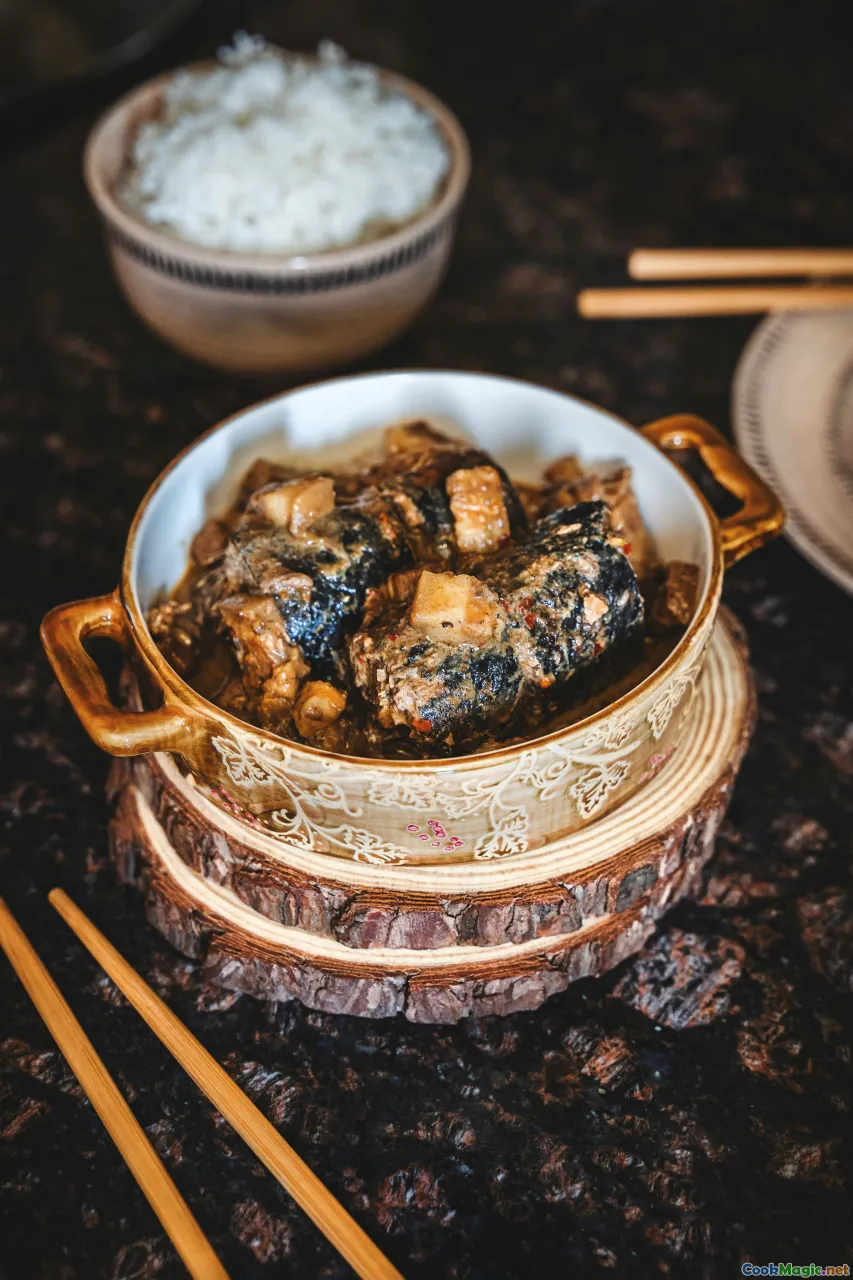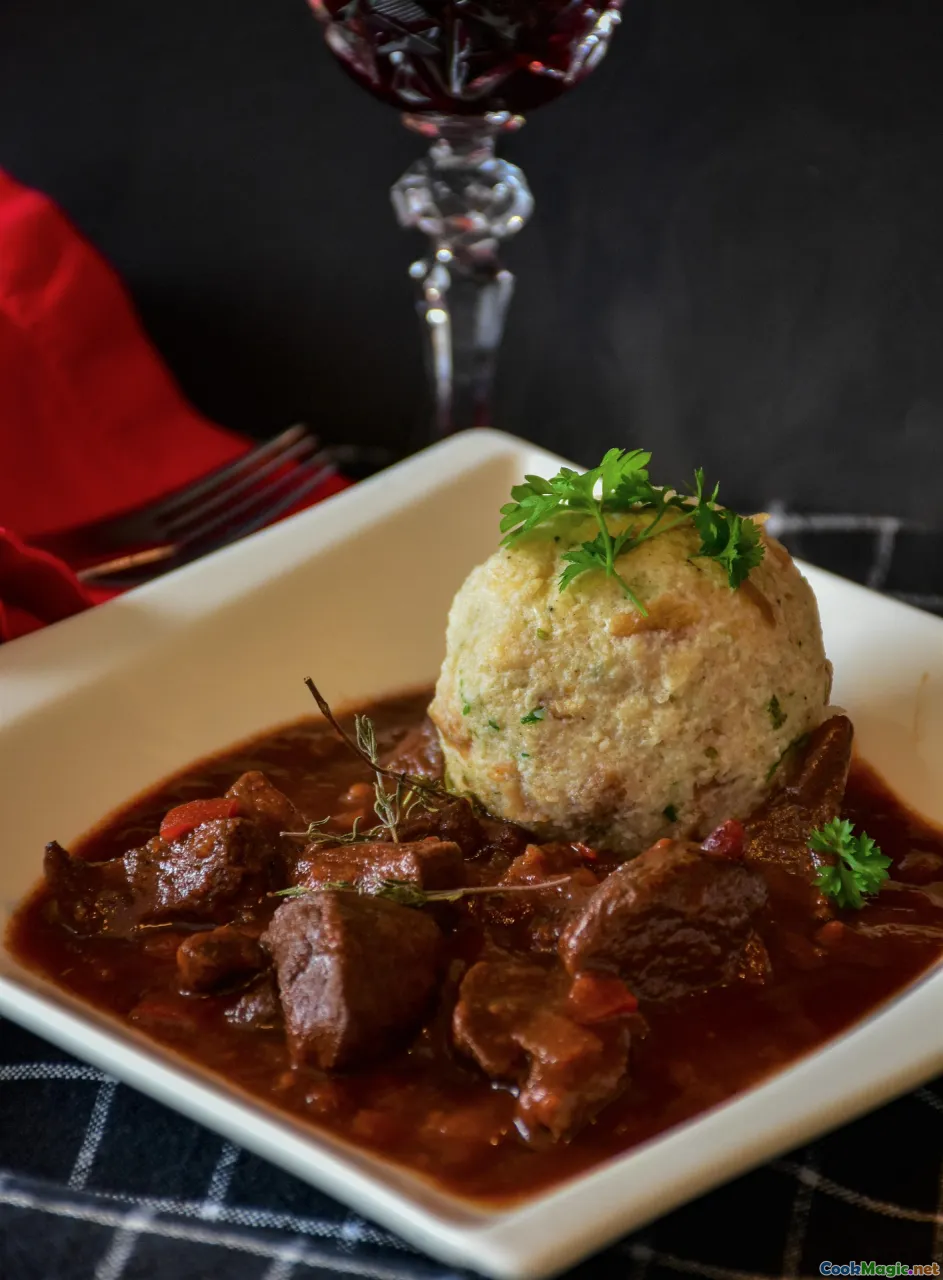
Ragoût Rustique de Boulettes aux Herbes de Braemar : Saveur Écossaise Consistante
(Rustic Braemar Herb Dumpling Stew: Hearty Scottish Flavour)
(0 Avis)0
1,037
août 14, 2025
Signaler un problème
Ingrédients
-
600 grams viande à ragoût de bœuf
(Chuck or stewing steak, cut into bite-size pieces)
-
1 large Oignon
(Haché)
-
3 medium Carottes
(Épluché et tranché)
-
1 large Panais
(Épluché et coupé en dés)
-
150 grams Navet (rutabaga)
(En dés)
-
3 cloves Gousses d'ail
(Haché)
-
2 medium céleri branche
(Haché finement)
-
1.2 litres Bouillon de boeuf
(Préférence pour faible teneur en sodium)
-
2 tbsp Sauce Worcestershire
-
1 tbsp Purée de tomates
-
3 tbsp Persil frais
(Haché finement)
-
1 tbsp Thym Frais
(Haché finement)
-
2 tbsp Ciboulette fraîche
(Haché finement)
-
2 tbsp Beurre
-
2 tbsp Huile d'olive
Feuille de laurier, 2
Feuille de laurier (pour les raviolis), 1
-
140 grams Farine tout usage
(For dumplings)
-
1.5 tsp Poudre à lever
(For dumplings)
-
1 tsp Sel
(Plus selon votre goût)
-
2.5 tbsp Beurre froid
(For dumplings, cut into small cubes)
-
130 ml Lait
(For dumplings; add gradually for dough consistency)
-
1 tsp Poivre noir moulu
(Plus extra for seasoning to taste)
-
90 grams Petits pois (surgelés)
(Add at the end for freshness)
(Chuck or stewing steak, cut into bite-size pieces)
(Haché)
(Épluché et tranché)
(Épluché et coupé en dés)
(En dés)
(Haché)
(Haché finement)
(Préférence pour faible teneur en sodium)
(Haché finement)
(Haché finement)
(Haché finement)
(For dumplings)
(For dumplings)
(Plus selon votre goût)
(For dumplings, cut into small cubes)
(For dumplings; add gradually for dough consistency)
(Plus extra for seasoning to taste)
(Add at the end for freshness)
Nutrition
- Portions: 4
- Taille de portion: Un bol profond (environ 400 g)
- Calories: 575 kcal
- Carbohydrates: 41 g
- Protein: 38 g
- Fat: 28 g
- Fiber: 8 g
- Sugar: 10 g
- Sodium: 1180 mg
- Cholesterol: 110 mg
- Calcium: 168 mg
- Iron: 5.2 mg
Instructions
-
1 - Brown the Beef:
In a large heavy-bottomed pot, heat olive oil over medium-high heat. Add beef in batches and sear until browned all over. Remove to a plate and set aside.
-
2 - Sauté Aromatics & Vegetables:
Reduce heat to medium. Add butter, then add onion, celery, carrots, parsnip, and swede. Cook 7-8 minutes, stirring so nothing burns.
-
3 - Add Garlic & Tomato Purée:
Add minced garlic, cook for 1 minute, then stir in tomato purée and cook another 2 minutes for depth.
-
4 - Combine and simmer:
Return beef and any juices to the pot. Pour in beef stock and Worcestershire sauce. Toss in bay leaf, black pepper, and a pinch of salt. Bring to a boil, cover, and simmer gently for 55-60 minutes until beef is tender.
-
5 - Make Herb Dumplings:
While the stew simmers, make dumplings: Mix flour, baking powder, salt in a bowl. Rub in cold butter to breadcrumb texture. Stir in half the parsley, all the chives, thyme, and optional crushed bay leaf. Gradually add milk to form a soft dough. Form 8 small balls.
-
6 - Add Dumplings to Stew:
Lift the stew lid, remove bay leaf, discard. Drop dumplings onto stew surface (spread apart). Sprinkle with remaining herbs. Replace lid and cook over a gentle simmer for 18-20 mins until dumplings double in size and are cooked through.
-
7 - Finish and Serve:
Stir in peas, adjust salt and pepper. Ladle hearty stew and fluffy dumplings into bowls. Garnish with extra herbs if you like.
In a large heavy-bottomed pot, heat olive oil over medium-high heat. Add beef in batches and sear until browned all over. Remove to a plate and set aside.
Reduce heat to medium. Add butter, then add onion, celery, carrots, parsnip, and swede. Cook 7-8 minutes, stirring so nothing burns.
Add minced garlic, cook for 1 minute, then stir in tomato purée and cook another 2 minutes for depth.
Return beef and any juices to the pot. Pour in beef stock and Worcestershire sauce. Toss in bay leaf, black pepper, and a pinch of salt. Bring to a boil, cover, and simmer gently for 55-60 minutes until beef is tender.
While the stew simmers, make dumplings: Mix flour, baking powder, salt in a bowl. Rub in cold butter to breadcrumb texture. Stir in half the parsley, all the chives, thyme, and optional crushed bay leaf. Gradually add milk to form a soft dough. Form 8 small balls.
Lift the stew lid, remove bay leaf, discard. Drop dumplings onto stew surface (spread apart). Sprinkle with remaining herbs. Replace lid and cook over a gentle simmer for 18-20 mins until dumplings double in size and are cooked through.
Stir in peas, adjust salt and pepper. Ladle hearty stew and fluffy dumplings into bowls. Garnish with extra herbs if you like.
En savoir plus sur: Ragoût Rustique de Boulettes aux Herbes de Braemar : Saveur Écossaise Consistante
Braemar Herb Dumpling Stew
Introduction & Origins
Braemar Herb Dumpling Stew is a savory celebration of Scotland's rustic culinary spirit and the comforting charms of the British Isles. This dish draws inspiration from the old Victorian village of Braemar, nestled amidst Aberdeenshire moors, famed for its Highland gatherings and chilly highland evenings—where such a stew would provide warmth after a day outdoors. Here, tender chunks of beef and a colorful medley of root vegetables are gently simmered, while feather-light dumplings, flecked with garden-fresh herbs, cook atop the stew, absorbing the aromatic broth and infusing it with a layered flavor profile.
This recipe isn’t just a standard stew. By combining classic British root veggies—swede, parsnip, and carrot—with contemporary herb dumplings, this takes tradition and laces it with creativity and freshness. Braemar stew projects the best values of Scottish hospitality: abundance, warmth, and heart.
What Makes This Dish Special?
Unique Features:
-
Scots-Inspired Dumplings: Unlike some denser suet dumpling recipes, these dumplings are light, dotted with bright chopped chives, parsley, and thyme, resulting in subtle herbal pops and aroma.
-
Root Vegetable Base: This version foregrounds earthy, quintessentially Scottish roots—carrots, swede and parsnip—making for a heartier, more flavorful, and texturally complex base than plain beef stew.
-
Double-Broth Magic: With both butter-fried vegetables and beef that’s seared to caramelized perfection, their combination in a savory low-sodium stock yields a deep, gutsy flavor. The optional crushed bay leaf in the dumpling dough is a unique touch.
-
Final Herb Burst: Stir in fresh parsley and peas at the end for a color and flavor lift—signaling the recipe’s gentle move into modern culinary trends while staying utterly traditional at heart.
Preparation & Cooking Tips
- Meat: For best results, use succulent beef cuts like chuck or stewing steak. Brown in batches to avoid steaming.
- Vegetables: Cut veggies into evenly-sized pieces for even cooking. Variation with leeks or celeriac is welcome, especially if adapting with vegetables in season.
- Stock: Opt for well-flavored, not overly salty beef broth. For more Scottish character, use a splash of Scotch whisky during deglazing.
- Dumplings: Handle the dough as little as possible and gently roll into balls—overworking makes them dense. If you want fluffier dumplings, mix dough just until it comes together, then cover and let rest briefly before forming.
- Simmer: After the dumplings go in, don’t boil—keep at a gentle simmer and don’t peek for the first 15 minutes, as the steam is crucial for their rise.
- Reheating: The stew keeps well for 2-3 days refrigerated—just remove and reheat the stew first, then float fresh dumplings for the second go-round rather than reheating the old ones.
Cultural and Family Notes
In Scotland and many rural English towns, such dumpling-topped stews are core to household cooking, fueled by the Old World principle of turning humble ingredients into life-sustaining comfort. Meat stews were a way to feed big families on small budgets—adding nutty/tender dumplings made the broth go further and stretched the food stores during lean months. Today, this is slow-food at its finest: hands-on, Aromatic, and warming.
Homely enough for Sunday family dinner yet impressive for guests, this stew captures why people return, winter after winter, to “mealie dumplings,” or the simple ritual of soaking bread in coal-fire stew. Dumplings should always be served with a flourish—and, traditionally, with a hunk of crusty “batch bread” to sop up every last drop.
Final Thoughts
Serve this stew steaming in deep bowls, adorned with a flutter of fresh herbs. In true Braemar tradition, let everyone scoop out their own fluffy dumplings straight from the pot, maybe with a dram of whisky or a pint of fine ale.
This isn’t just a bowl of stew—it’s a bridge to the wild, bracing heather moors and family tables handed down through stories and recipes. Cozy up, take in the aroma, and taste a little of Scotland’s soul in every spoonful.
























